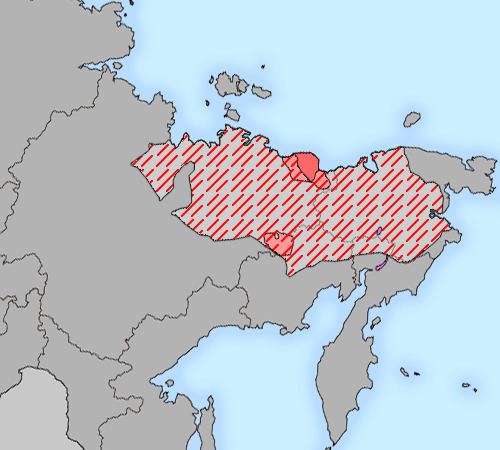Glottolog yuka1259 | Linguistic classification Uralic–Yukaghir? | |
 | ||
Ethnicity Yukaghirs, Chuvans, Anauls Subdivisions NorthernOmok †Chuvan †Southern | ||
The Yukaghir languages (/ˈjuːkəɡɪər, juːkəˈɡɪər/; also Yukagir, Jukagir) are a small family of two closely related languages—Tundra and Kolyma Yukaghir—spoken by the Yukaghir in the Russian Far East living in the basin of the Kolyma River. At the 2002 Russian census, both Yukaghir languages taken together had 604 speakers. Recent reports from the field reveal that this number is far too high: the Yukaghir languages have at most seventy to eighty speakers. The entire family is thus to be regarded as moribund.
Contents
Classification and grammatical features
The relationship of the Yukaghir languages with other language families is uncertain, though it has been suggested that they are distantly related to the Uralic languages, thus forming the putative Uralic–Yukaghir language family.
Tundra and Kolyma Yukaghir are the only two remnants of what used to be one of the dominant languages/language families of northeastern Siberia, spreading from the River Anadyr in the east to the River Lena in the west. On the basis of the evidence of early sources, it can be assumed that there existed a Yukaghir dialect continuum, with what is today Tundra Yukaghir and Kolyma Yukaghir at the extremes.
These two languages share only a relatively small part of the vocabulary and are not mutually intelligible. The basic grammatical structures, however, are very similar. Both languages have residual vowel harmony and a complex phonotactics of consonants. Both have rich agglutinative morphology and are strictly head-final. There is practically no finite subordination and very few coordinate structures. The most spectacular feature of TY and KY grammar is the split intransitive alignment system based on discourse-pragmatic features. In absence of narrow focus, the system is organised on the nominative–accusative basis; when focused, direct objects and subjects of intransitive verbs are co-aligned (special focus case, special focus agreement).
Members
The two extant varieties of Yukaghir are:
Extinct varieties include Omok and Chuvan, which survived until perhaps the 18th century.
